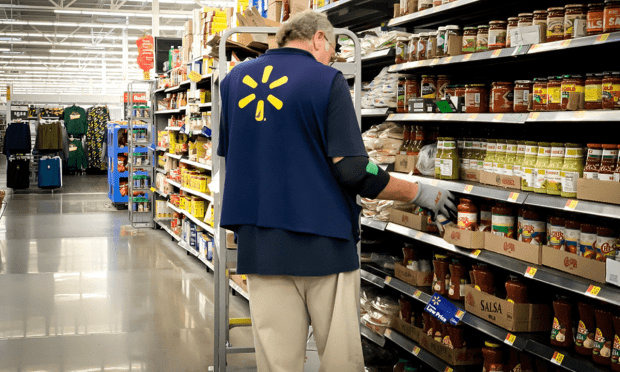Walmart’s Grocery Gains Could Be Mixed Blessing as Shoppers Trade Down

Amid ongoing inflation, many consumers are growing more conservative in their spending, cutting back on luxuries and sticking more to the basics. Walmart, the world’s largest grocery retailer, is seeing the effects of the shift from restaurants to supermarkets as well as from more premium-priced food retailers and items to more value-focused alternatives.
Yet, on a call with analysts Tuesday (Aug. 16) discussing the company’s second-quarter financial results, Walmart CEO Doug McMillon shared that, while this trend may have its benefits in terms of market share, it comes with its drawbacks when it comes to profit margins.
“The cost of food and fuel [and] a heavier mix of sales in food and consumables … were among the most challenging items for us at the time,” McMillon said. “We continue to see a heavier mix of sales in food and consumables in many of our markets, and that put pressure on margins overall.”
Walmart’s food business is its single-largest source of revenue and is most profitable when it serves as a draw to get consumers inside the store (or onto the website or app) where they can then purchase additional higher-margin items.
However, with food growing more expensive for retailers, and with the need for the retailer to absorb some of these price increases to maintain its competitive advantage, the shift toward grocery purchases poses its challenges.
Consumers have not only been shifting their spending toward grocery but also choosing lower-cost foods when they do so.
“As an example, instead of deli meats at higher price points, customers are increasing purchases of hotdogs as well as canned tuna or chicken,” Walmart Executive Vice President and Chief Financial Officer John David Rainey said on the call. “Private brand penetration has also inflected higher.”
Walmart’s ability to price out competitors makes it an attractive prospect to consumers looking to cut back on food spending, and McMillon noted that the company’s strength in grocery is “leading to market share gains,” which the company attributed to Nielsen but did not specify.
Most consumers are at least a little bit nervous about their ability to get food on the table. According to data from PYMNTS’ “Consumer Inflation Sentiment” study, which draws from a July survey of nearly 3,800 U.S. adults, only 37% of consumers agree with the sentiment: “I have no worries about how to afford food or basic needs for me and my family,” leaving nearly two-thirds with at least some anxiety about feeding themselves and their family.
Get the report: Consumer Inflation Sentiment: July 2022 — Consumers Pull Back and Prepare for the Long Haul
Additionally, consumers are highly sensitive to the price increases they are seeing at the grocery store. Findings from a national online study of 3,783 consumers conducted by PYMNTS last month revealed that consumers report paying 20% to 30% more for retail and grocery purchases and to eat at restaurants. Yet, July’s Consumer Price Index for All Urban Consumers (CPI-U) data, reported by the U.S. Bureau of Labor Statistics (BLS) noted that grocery prices increased significantly less, 13%, and restaurant prices rose 8%.
See also: Why Retailers Should Worry About Inflation but Dread the Wealth Effect
As much as Walmart said the current pricing environment has seen more middle- and higher-income consumers coming to it in search of deals, it remains to be seen if the retailer will be able to retain the loyalty of these newcomers and convert them into long-term customers.
